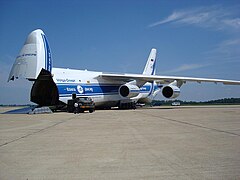
Back Avión de transporte AN طائرة شحن Arabic Avión de carga AST Yük təyyarəsi AZ Товарен самолет Bulgarian Avió de càrrega Catalan فڕۆکەی بارھەڵگر CKB Nákladní letadlo Czech Transportfly Danish Frachtflugzeug German
This article needs additional citations for verification. (September 2018) |

A cargo aircraft (also known as freight aircraft, freighter, airlifter or cargo jet) is a fixed-wing aircraft that is designed or converted for the carriage of cargo rather than passengers. Such aircraft generally feature one or more large doors for loading cargo. Passenger amenities are removed or not installed, although there are usually basic comfort facilities for the crew such as a galley, lavatory, and bunks in larger planes.[1] Freighters may be operated by civil passenger or cargo airlines, by private individuals, or by government agencies of individual countries such as the armed forces.
Aircraft designed for cargo flight usually have features that distinguish them from conventional passenger aircraft: a wide/tall fuselage cross-section, a high-wing to allow the cargo area to sit near the ground, numerous wheels to allow it to land at unprepared locations, and a high-mounted tail to allow cargo to be driven directly into and off the aircraft.
By 2015, dedicated freighters represent 43% of the 700 billion ATK (available tonne-kilometer) capacity, while 57% is carried in airliner's cargo holds. Also in 2015, Boeing forecast belly freight to rise to 63% while specialised cargoes would represent 37% of a 1,200 billion ATKs in 2035.[2] The Cargo Facts Consulting firm forecasts that the global freighter fleet will rise from 1,782 to 2,920 cargo aircraft from 2019 to 2039.[3]
- ^ "Flying in Cargo Class: The Anatomy of an Air Freighter". 4 February 2015.
- ^ "World Air Cargo Forecast" (PDF). Boeing. 2016.
- ^ "2800+ new freighters to be added in the next 20 years, forecast finds". Cargo Facts. May 8, 2019. Archived from the original on July 2, 2019. Retrieved July 2, 2019.